| Article ID | Journal | Published Year | Pages | File Type |
|---|---|---|---|---|
| 2593523 | Reproductive Toxicology | 2014 | 8 Pages |
•Human placenta has little capacity to restrict fetal exposure to Bisphenol A.•The fetal capacity to extrude Bisphenol A-Glucuronide is limited.•It is unlikely that the fetus is overexposed to Bisphenol A compared to its mother.
The widespread human exposure to Bisphenol A (BPA), an endocrine disruptor interfering with developmental processes, raises the question of the risk for human health of BPA fetal exposure. In humans, highly variable BPA concentrations have been reported in the feto-placental compartment. However the human fetal exposure to BPA still remains unclear. The aim of the study was to characterize placental exchanges of BPA and its main metabolite, Bisphenol A-Glucuronide (BPA-G) using the non-recirculating dual human placental perfusion. This high placental bidirectional permeability to the lipid soluble BPA strongly suggests a transport by passive diffusion in both materno-to-fetal and feto-to-maternal direction, leading to a calculated ratio between fetal and maternal free BPA concentrations of about 1. In contrast, BPA-G has limited placental permeability, particularly in the materno-to-fetal direction. Thus the fetal exposure to BPA conjugates could be explained mainly by its limited capacity to extrude BPA-G.
